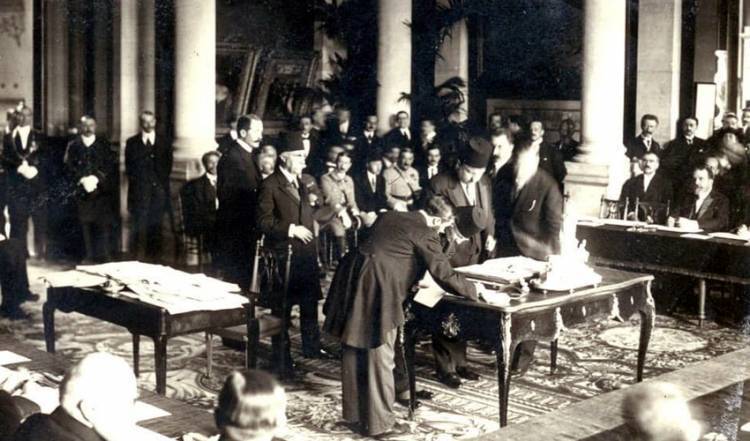The Treaty of Batumi: Part 1
04.06
2025
The Armenian People on the Eve of the Treaty’s Conclusion
In order to fully and objectively understand the Treaty of Batumi, which is being criticized mainly by anti-national forces, it is necessary, first of all, to know what the situation leading up to it was in Transcaucasia and the world. 1918 was a difficult year for Transcaucasia. After the October Revolution, the control of the Russian Empire over Transcaucasia was lost. The Russian Empire had collapsed, and the Bolshevik revolution had created a political vacuum in the Caucasus. The treaty was signed amid a situation where the newly independent Republic of Armenia was in an extremely difficult military, economic, and political position. The Armenian people had not yet recovered from the catastrophe of the genocide and faced a new aggression from the Ottoman Empire. Although the May battles changed many things, the limited military resources, the lack of external support, and the uncertain military-political situation forced Armenia to seek diplomatic solutions. Even after the May battles, the Turkish military pressure continued.
It is obvious that Turkey, whenever it finds it advantageous, can violate any agreement in pursuit of its interests, which, unfortunately, the current Armenian government does not take into account.
In April 1918, violating the Treaty of Brest-Litovsk, Turkey occupied Batumi, Ardahan, and Kars. Under pressure, on April 9, 1918, the Transcaucasian Seim issued a declaration separating Transcaucasia from Russia and declaring it an independent state—the Transcaucasian Democratic Federative Republic. Naturally, first of all, it was necessary to establish a new relationship with Turkey and at least temporarily break away from Bolshevik Russia. Thus, the agenda was to revise the Brest-Litovsk Treaty, but Armenia’s independence created new opportunities for Turkey to carry out invasions. Indeed, the threat of Turkish invasion became more real for the Eastern Armenians as well. The Ottoman government again employed its traditional military and political strategy: negotiate on one hand, and on the other, try to seize new territories by force, exert pressure on diplomatic negotiations (as now—a tactic we did not adopt in 1994). Let us remember that Turkey also used this tactic in the Turkish-Transcaucasian diplomatic negotiations in Trabzon and Batumi. According to Av. Aharonyan, “The Transcaucasian Seim and government were far from realizing the seriousness of this threat and were unable to fulfill such a heavy duty.” The leadership of Transcaucasia believed that the concessions made under the Brest-Litovsk Treaty would end the war and bring peace to the region (as it is today, when some think that giving up Artsakh will lead to peace, and, ignoring lessons from history, they keep making mistakes one after another). On the one hand, the Turks continued to achieve military success at the front, and on the other, the South Caucasus was separated from a Russia torn by civil war and weakened. Under these circumstances, the only option was for the Transcaucasian government to seek a peace treaty with Turkey to stop the invasion. On April 10, 1918, the new head of the Transcaucasian government and foreign minister, A. Chkhenkeli, sent a telegram to the Turkish army commander Vehip Pasha, stating that his government accepted the Brest-Litovsk peace treaty and asked to cease military operations and resume negotiations interrupted in Trabzon. Simultaneously, despite Armenian resistance and protests, A. Chkhenkeli’s government agreed to withdraw troops from the Kars region, retreat to the Akhuryan River, and destroy the fortifications in Alexandropol on the river’s right bank. On April 11, A. Chkhenkeli and the acting Minister of War of the Transcaucasian government, I. Odishelidze, ordered T. Nazarbekyan to leave Kars. The next day, the Turks captured Kars, and with the fall of Kars and Batumi, as noted by Y. Irazek (Hakob Ter-Hakobyan), “the keys to all of Transcaucasia were in their hands, so why come to peace when they could seize the desired territories with minimal sacrifices.” Turkey then regarded its pan-Turkist idea as feasible: to seize the South Caucasus, invade Iran and Central Asia. However, at this moment, Turkey faced serious tensions with its ally Germany. Turkey’s growing power and the aforementioned plans threatened Germany’s strategic and economic interests, as Turkey would block its access to the territories and resources of the South Caucasus, especially Baku oil. The same situation arose in 1942 before the Battle of Stalingrad, when Turkey, which had decided to open a second front in Transcaucasia in case of a German victory, would endanger Germany’s possession of the riches of Transcaucasia, the railway network of Transcaucasia, and the natural resources of Georgia, in particular manganese, which was desperately needed in German metallurgical plants. All this was immediately taken into account by the ARF, and through Dro and Nzhdeh, steps were taken to form cooperation with Germany for the defense of Armenia. In our opinion, this was the greatest diplomatic step in centuries of diplomacy, to stop Turkey’s invasion of Armenia with such a step.) Therefore, the Germans immediately began negotiations with the Georgians, in particular A. Chkhenkeli, promising in return to ensure and protect Georgia’s security and borders.
Germany was not economically interested in Eastern Armenia, but part of the railway junction of the region passed through Armenia, which also became a kind of “hub” for the clash of political and economic interests between Turkey and Germany. An interesting situation arose: on the one hand, the Germans promised to support the Armenians, on the other hand, first, they were participants in the Armenian Genocide and did not inspire confidence, and second, because of the Armenians they did not want to turn the contradictions with Turkey into a conflict. Indeed, the situation was very difficult. Under these conditions, Germany demanded that Turkey stop the military advance and sit at the negotiating table. On April 27, 1918, a secret German-Turkish treaty was signed in Constantinople, by which Transcaucasia was divided into spheres of influence. Remaining true to its maximalist policy, on the same day, when the ink was still wet on the signed treaty, Turkey signed a secret treaty with the Musafats in order to bypass the German-Turkish treaty. Later, the Germans realized that they had been deceived.
Events developed rapidly, and on April 28, Turkey agreed to meet with the Transcaucasian government in Batumi for negotiations. However, subsequent events took a different course due to disagreements between German and Turkish policy and among the Transcaucasian Seim members: on May 26, 27, and 28, three independent states emerged in the region instead of a unified Transcaucasian government. Due to external factors, the artificial union of the South Caucasus into one state was unable to resolve internal contradictions. This union lasted only 47 days—from April 9 to May 26. The disintegration of Transcaucasia became inevitable. Thus, on the eve of the Batumi Treaty, Turkey was backing Azerbaijan, Germany was supporting Georgia, while Armenia was completely alone.





